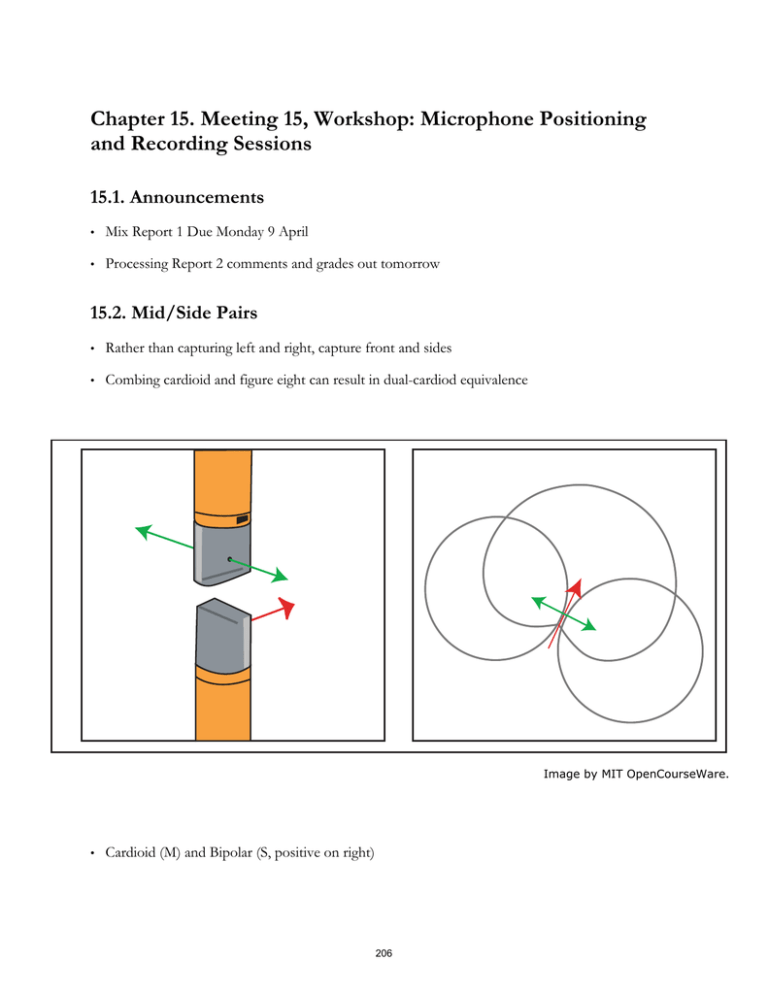
Chapter 15. Meeting 15, Workshop: Microphone Positioning
and Recording Sessions
15.1. Announcements
•
Mix Report 1 Due Monday 9 April
•
Processing Report 2 comments and grades out tomorrow
15.2. Mid/Side Pairs
•
Rather than capturing left and right, capture front and sides
•
Combing cardioid and figure eight can result in dual-cardiod equivalence
Image by MIT OpenCourseWare.
•
Cardioid (M) and Bipolar (S, positive on right)
206
•
Cardioid (M): receives coincident R + L
© PAiA Corporation USA (Scott Lee). All rights reserved. This content is excluded from
our Creative Commons license. For more information, see http://ocw.mit.edu/fairuse.
•
Bipolar (S): receives coincident R - L
Sounds arriving to the bipolar microphone are stamped with polarity
© PAiA Corporation USA (Scott Lee). All rights reserved. This content is excluded from
our Creative Commons license. For more information, see http://ocw.mit.edu/fairuse.
•
Converting MS to LR
Take M (R+L) and add side (R-L): return 2R
Or: take front and remove all signals in phase with the left (leaving the right-most capture)
Take M (R+L) and add inverse side (-R+L): return 2L
Or: take front and remove all signals in phase with the right (leaving the left-most capture)
207
© PAiA Corporation USA (Scott Lee). All rights reserved. This content is excluded from
our Creative Commons license. For more information, see http://ocw.mit.edu/fairuse.
•
Summarized post processing of M/S to L/R signals
•
L == (M + S) / 2
•
R == (M - S) / 2
•
Polarity of figure-eight mic is important: right is positive
•
Decoding MS in a DAW requires three tracks
Side track is duplicated and panned hard left and hard right
Right side track is inverted (use Live Utility plugin)
208
© Universal Audio. All rights reserved. This content is excluded from our Creative
Commons license. For more information, see http://ocw.mit.edu/fairuse.
Source: http://www.uaudio.com/blog/mid-side-mic-recording/
15.3. Mid-Side Advantages
•
Can easily get an on-axis, mono capture
•
Cardiod is on-axis: a potentially better-sound capture
•
Can control width of stereo capture in mix
15.4. MOSS Microphones
•
AKG C414 XL II (4)
Large-diaphragm condensor; multi polar pattern (cardioids, omni, figure-eight)
209
•
Audio-Technica AT4041 (6)
Small-diaphragm condensor; cardioid polar pattern
•
TC20mp (2)
Small-diaphragm condensor; omni polar pattern
•
Mojave Audio MA-200 (1)
© (from top) AKG Acoustics GmbH, Audio-Technica US, Inc, and Earthworks Audio. All rights reserved. This content
is excluded from our Creative Commons license. For more information, see http://ocw.mit.edu/fairuse.
210
Large-diaphragm tube condensor; cardioid polar pattern
•
Sennheiser MD 421 (2)
Dynamic; cardioid polar pattern
•
Shure SM57 (2)
Dynamic; cardioid polar pattern
•
Royer R-101 (1)
Ribbon; figure-eight polar pattern
© (from top) Mojave Audio, Sennheiser, and Shure Inc. All rights reserved. This content is excluded
from our Creative Commons license. For more information, see http://ocw.mit.edu/fairuse.
211
•
AT M250DE (1)
Dual-element instrument microphone
•
e604 (1)
Dynamic cardioid w/ more than 160 dB dynamic range
© Royer Labs (top), Audio-Technica US Inc (bottom). All rights reserved. This content is excluded
from our Creative Commons license. For more information, see http://ocw.mit.edu/fairuse.
212
•
Blue enCORE 200 (4)
Active dynamic cardioid
© Sennheiser (top), Blue Microphones (bottom). All rights reserved. This content is excluded
from our Creative Commons license. For more information, see http://ocw.mit.edu/fairuse.
15.5. Stereo Positioning Review Sheet
•
•
Coincident
•
XY: two cardioids, splay between 60 and 120 degrees
•
MS: one cardioid, one figure-eight, 90 degrees between mid and side
•
Blumlein: two figure eights at 90 degrees
Near-coincident
213
•
•
ORTF: two cardioids, 6.7 inches apart, 55 degrees splay from forward
•
NOS: two cardioids, 11.8 inches apart, 45 degrees from forward
•
Faulkner: two figure-eights, 7.9 inches apart, facing forward
Spaced
•
AB: two omnis spaced between 2 and 10 feet (or more) apart
15.6. Procedure
1. Review Mics
2. Groups
Each group contains 3 or 4 students (names removed for privacy)
3. Setup stereo configuration based on assignment on card
4. Identify and describe adjacent microphone configuration
214
MIT OpenCourseWare
http://ocw.mit.edu
21M.380 Music and Technology: Recording Techniques and Audio Production
Spring 2012
For information about citing these materials or our Terms of Use, visit: http://ocw.mit.edu/terms.




